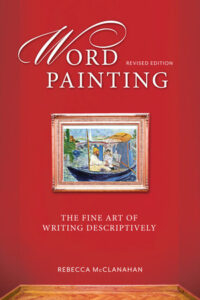
Beautiful View? How so?
You turn the pages of what promised to be a ripping yarn.
But “it” happens again.
On the very first page, you read “It was a beautiful view.”
A few pages later, again, a similar example pops up:
“James is a big man, and a bad one, too.”
Beautiful. Big. Bad. How so? Details, please.
Weak words. Subjective words. Lazy words.
Beautiful, big, and bad mean different things to different people. Sometimes using a subjective word works, other times not so much.
You put the book down or back on the shelf.
Not too many days ago, I experienced this very scenario. And I remembered a book about writing that stayed with me, one I cannot recommend highly enough.
 Rebecca McClanahan’s Word Painting: A Guide to Writing More Descriptively became one of those rare books I re-read, dipping into often, reminding myself of certain things, yanking me back on track, inspiring me, leading me to approach writing with fresh eyes and mind and heart.
Rebecca McClanahan’s Word Painting: A Guide to Writing More Descriptively became one of those rare books I re-read, dipping into often, reminding myself of certain things, yanking me back on track, inspiring me, leading me to approach writing with fresh eyes and mind and heart.
Where to start, as this treasure chest of a book contains many gems of practicality, theory, and wisdom?
Word Painting’s chapters two and three are perhaps the most important of the ten chapters, because those two focus on the eye and visual observation. But the other senses get their time under the magnifying glass as well.
McClanahan delves into the subject of descriptive writing through both her own experiences and examples taken from dozens of the greats of literature. Flannery O’Connor. Annie Dillard. Tim O’Brien. James Baldwin. And many, many more.
It’s the “telling detail” that amplifies the story. Be it fiction, poetry, or nonfiction, McClanahan suggests a specific word works better than a label or explanation. Hence, the writer of that ripping yarn ought to use a word other than “beautiful” to describe the day, or paint a word portrait of a man besides “big” and “bad.”
But McClanahan doesn’t focus on words alone.
No, she takes you, the writer/reader, even further into the process of description, to the doorway of the “fictional dream.” And that, to me, is the goal, even in nonfiction, which I write more than fiction or poetry. As McClanahan says, “The creative part of nonfictions lies elsewhere, in the way our imaginative eye views the factual world—selecting details, combining and recombining information, and reshaping experience.” In other words, “From the hard rock of fact, stone by stone, the writer builds a castle.”
I’ve adopted many very useful techniques from Word Painting. One in particular—free associating—requires listing all the words I associate with an object, creating a word tree emerging from my subconscious.
Another takeaway from Word Painting lies in the clarification of the difference between “telling” and “showing,” an old bugaboo plaguing writers both old and new.
At the end of each chapter, McClanahan includes a series of exercises meant to shake loose writerly inertia and inspire you to make concrete, in your way, the ideas discussed in the preceding chapter. McClanahan sums it up well: “We are the most original when we are most ourselves.”
Do take a look at Word Painting: A Guide to Writing More Descriptively. You will likely begin to notice all those weak, subjective, lazy words, too.
For more on writing descriptively:
Although I’ve found many websites devoted to descriptive words, I prefer books, for the thrill of discovery as I turn the pages. You might also check out glossaries related to topics you write about.
Authorisms, by Paul Dickson
The Art of Description: World into Word, by Mark Doty
The Describer’s Dictionary, by David Grambs
Dimboxes, Epopts, and Other Quidams: Words to Describe Life’s Indescribable People, by David Grambs
The Insomniac’s Dictionary, by Paul Hellweg
[Editor’s note: WAG would love to see articles on any and all topics of interest to writers. Please send your ideas or finished pieces to Cynthia D. Bertelsen at BlogEditor@writersalliance.org for consideration. Remember: these posts are more than just posts, for they are actual articles and can be cited in your CV/résumé in the same way you would a short story, essay, or any other writing credit you may possess.]

Jess Elliott
Terrific article, Cindy!
Will hunt up these books.
Cynthia D. Bertelsen
Thanks, Jess. “Word painting” is one book I would keep through any purge of books (and I did!).
Suzanne S Byrne
Thank you!
I’m in my umpteenth revision of a YA novel. I’m revising for just that – description. I sometimes forge ahead with dialogue when I need to stop, take a moment to feel, and describe what the character sees, hears, and tastes. I’ve also found that description can open the way to backstory, or more fully reveal what the character is about. I will certainly take a look at “Word Painting.”
Cynthia D. Bertelsen
Suzanne, well said. I tend to get it all out, on “paper” (actually screen) and fill in the blanks, so to speak.
Mary Bast
This post is now bookmarked under my “Writing” bookmark, and especially timely as I’m in the poetry class with Bill Snyder offered by WAG, where the details are vital to a poem. Thanks!
Cynthia D. Bertelsen
I’m hoping to be in the next rendition of that class in October. Please write a description of what you’ve learned for “Hogtowne Quill.”
Susie H. Baxter
I have ordered McClanahan’s book. Thanks for the recommendation! I enjoy your posts!
Cynthia D. Bertelsen
Susie, you will love it, I promise. And thanks for the comments.
Suzanne S Byrne
I ordered the Tribal Knot. The summary was terrific. I will surely learn a lot about history and painting with words.
Joan Carter
Without even reading the book, from what you’ve shared here, I can see what I need to do. Thanks!
Cynthia D. Bertelsen
Yes, but the book goes further, so … .